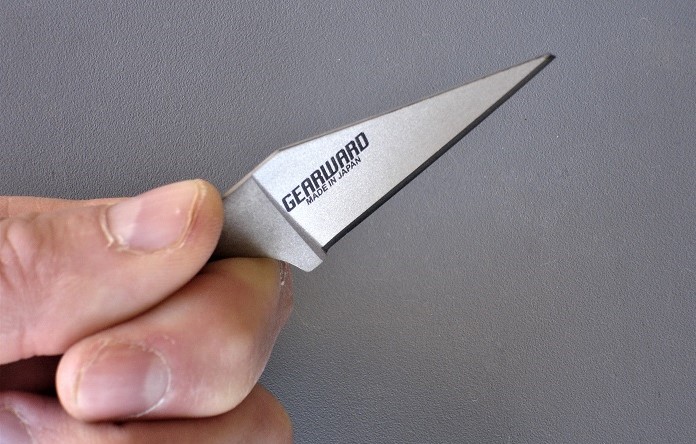The Gearward™ HermiSERE™ is a modern version of the British Special Operations Executive (SOE) lapel / thumb daggers that were issued to agents the SOE and the American Office of Strategic Services (OSS) during the Second World War.
SOE was a top secret British WW2 organization that was created on 22 July 1940, following the fall of France, Prime Minister Winston Churchill tasked Hugh Dalton with forming SOE. The SOE was formed from the merger of three existing secret and operating departments of other ministries to conduct sabotage, espionage and reconnaissance in Nazi-occupied France, and to aid local resistance movements. Churchill’s instructions to Dalton were to “set Europe ablaze.”
Colonel (later Major General) Sir Colin McVean Gubbins, KCMG, DSO, MC, was the prime mover on the SOE and from August 1943 onward, Director of SOE Sir Colin also was responsible for setting up the GHQ Auxiliary Units, a volunteer civilian force set up to resist any eventual occupation of the United Kingdom by Nazi Germany. He was the logical choice, since he had acquired considerable experience and expertise in guerrilla warfare as a regular Army officer.
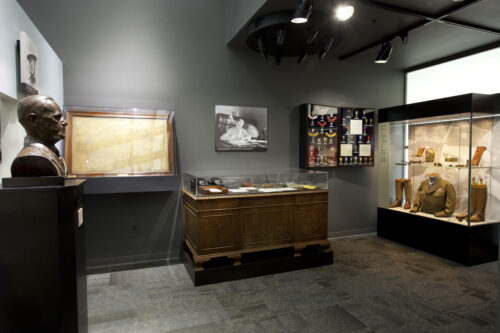
The Office of Strategic Services was established by President Roosevelt on 13 June 1942 with Colonel (later Major General) William J. (“Wild Bill“) Donovan as its head. The OSS was tasked to collect and analyze strategic information required by the Joint Chief of Staff and to conduct special operations not assigned to other agencies. Wartime activities included the collection of intelligence, sabotage, propaganda, assisting anti-Nazi resistance movements in Europe and providing military training for anti-Japanese guerrilla movements in Asia.
On 20 September 1945, following Victory over Japan, President Truman signed Executive Order 9621, which disbanded the OSS and split its functions between the Department of State and the Department of War.
The OSS was a predecessor of the Central Intelligence Agency. The OSS shoulder insignia lives on in the emblem of the US Special Operations Command.
The SOE was officially disbanded on 15 January 1946. Many of the duties of the SOE have been taken over by the Secret Intelligence Service (SIS), better known as MI6. A memorial to SOE’s agents was unveiled in London in October 2009. The memorial is situated on the Albert Embankment by Lambeth Palace.

A variety of edged weapons were manufactured specifically for the SOE and OSS during WW2. Lapel / thumb daggers were issued to agents operating behind enemy lines as part of their Escape and Evasion kit. They were designed as covert weapons that could be secreted and stitched behind the jacket lapels or anywhere about the clothing for maximum concealability and ease of access. The small dagger blade was quick to bring into action and effective for striking strategic anatomical targets at close range.
According Lieutenant Colonel LJC Wood, who was the Commanding Officer of Station 12, Aston House, which was the top secret SOE research and training establishment, the lapel / thumb dagger was invented by the legendary William E. Fairbairn and fellow close-combat instructor Eric Sykes, who were using Station 12 as a center for unarmed combat and pistol shooting.
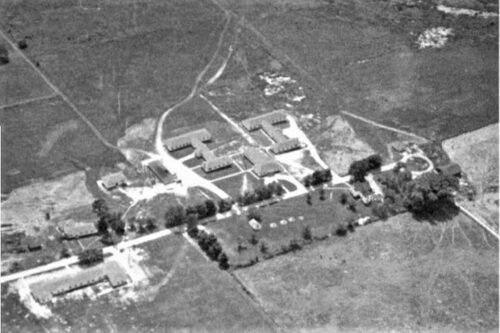
The original lapel /thumb daggers were manufactured by H. G. Long & Co in Sheffield and the sheaths were made by local Aston cobbler Arthur Acres. The television series Secrets of War, with Charlton Heston, suggested Fairbairn as one possible inspiration for Q Branch in the James Bond series.
The SOE set up an international network of top-secret training schools during the war to instruct prospective agents in the black arts of “ungentlemanly warfare.” Many Allied agents were trained at Camp X, which was established on 6 November 1941.
Located on a farm at Ajax, near Oshawa, Ontario, Canada, Camp X was jointly operated by the British Security Council (BSC) and the Government of Canada. Ian Fleming was among the operatives trained there. It’s believed that Fleming drew on his experience at Camp X when he created James Bond. The CIA named its recruit training facility “The Farm” as a nod to Camp X.
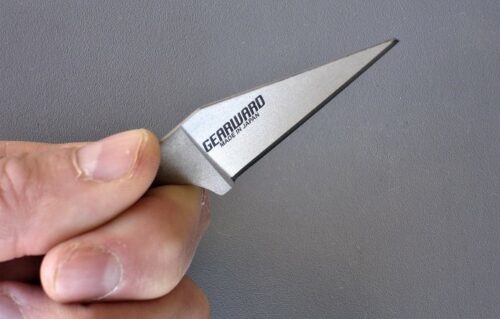
Fast forward to the Gearward HemiSERE. Although true to its World War II and subsequent Cold War era heritage, the HermSERE incorporates a number of modern improvements on the original designs.
The HemiSERE offers far superior ergonomics to the original lapel daggers. The HemiSERE has a deep finger choil locks the knife into the hand and causes the blade to project forward like a claw. Combined with the high performance Wharncliffe blade shape, which is optimized for maximum cutting power, this tiny knife offers a surprising amount of slashing performance.
A number of different materials were contemplated for the design. Steel was ruled out as it is heavy and magnetic. Ceramic was rejected since it is too delicate for a knife of this type. Materials such as carbon fiber, G10 and polymers weren’t considered because they can’t hold a cutting edge and are only useful for thrusting. Also, contrary to their use in so-called “covert knives” by some companies, carbon fiber is electrically conductive and may be detected by metal detectors, which work by sensing induced eddy currents. so there isn’t any advantage to them.
It should be noted that X-ray and full-body scanners, unlike metal detectors, can detect non-conductive objects. And, of course, all objects can be detected by physical search.
Titanium was viewed as the best candidate by Gearward, as it is strong, lightweight, and has a minimal magnetic signature. But normal titanium is too soft for use in knives, so Gearward sourced a special titanium/ceramic composite from Japan.
This material combines powdered titanium with powdered ceramic, which embeds thousands of microscopic pieces of ceramic along the edge of the blade. The result is a knife with the lightweight durability of titanium and with most of the edge retention of a ceramic blade. According to Gearworks, the knife outperforms steels hardened to 63 HRC on the CATRA test. Due to the edge retention, the HemiSERE can be counted on not only as a weapon, but also as a reliable cutting tool, making it well suited for inclusion in mini survival kits.
The HemiSERE is a truly compact fixed blade. At 3.375 inches long x 0.75 inch high x 0.05 inch wide, the knife is barely larger than a stick of chewing gum. Yet despite its small size, it packs a formidable 1.875-inch cutting edge, which is comparable to larger neck knives such as Emerson Knives La Griffe.
Even more impressive is its weight. The HemiSERE weighs only four grams—one gram less than a nickel. The feather weight reduces the metallic signature and allows the knife to be carried in unconventional places.
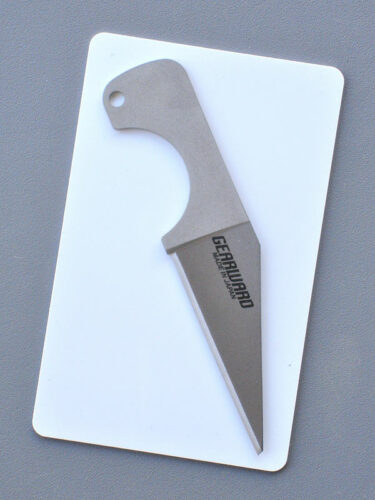
Instead of relying on a sheath, which adds bulk and reduces carry options, the HemiSERE uses innovative “glue dots” to attach the knife directly to clothing. Unlike other “lapel knives,” you really can wear this knife under your lapel, and you can also carry the knife by attaching it to a credit card, slipping it into a phone case, under an insole, or sticking it anywhere you can imagine.
The glue dots hold the knife securely but allow it to be easily removed by a tug on the handle. Glue/adhesive dots can be purchased at many stores, and a pack of 300 are sold on Amazon for about $6.00.
The design and workmanship on the HemiSERE are excellent. The HemiSERE is available directly from Gearward. Price is $40.00 Each HemiSERE comes with a blank credit card for wallet carry, along with 12 glue dots. Of course, check your local laws on ownership and carry.
Ratings
Cost: 4/5
Construction/Durability: 5/5
Functionality: 5/5 for intended purpose and within its limitations
Weight: 5/5
Overall Rating: 19/20
I was provided with this product as a courtesy from the manufacturer so I could test it and give my honest feedback. I am not bound by any written, verbal, or implied contract to give this product a good review. All opinions are my own and are based off my personal experience with the product.
*The views and opinions expressed on this website are solely those of the original authors and contributors. These views and opinions do not necessarily represent those of Spotter Up Magazine, the administrative staff, and/or any/all contributors to this site

